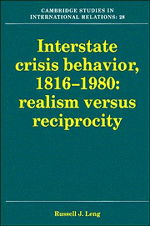Book contents
- Frontmatter
- Contents
- List of figures
- List of tables
- Preface
- 1 REALIST AND PSYCHOLOGICAL PERSPECTIVES
- 2 METHODOLOGY
- 3 THE CRISIS STRUCTURE AND WAR
- 4 PATTERNS OF BEHAVIOR
- 5 STRUCTURE, BEHAVIOR, AND OUTCOMES
- 6 INFLUENCE TACTICS
- 7 INFLUENCE STRATEGIES
- 8 RECIPROCATING INFLUENCE STRATEGIES
- 9 SUMMARY AND CONCLUSION
- EPILOGUE: THE 1990–1991 CRISIS IN THE PERSIAN GULF
- Appendices
- 1 Crises: standardized score on behavioral dimensions
- 2 Structural variables and predicted behavioral types
- 3 Crisis precipitant, first threat of force, escalation and outcome
- 4 Identifying influence strategies by time series
- 5 Identifying the predominant influence attempt strategy
- 6 Decision rules for identifying response strategies
- 7 Influence strategies
- Notes
- References
- Index of names
- Index of subjects
- Titles in the series
4 - Identifying influence strategies by time series
Published online by Cambridge University Press: 05 February 2010
- Frontmatter
- Contents
- List of figures
- List of tables
- Preface
- 1 REALIST AND PSYCHOLOGICAL PERSPECTIVES
- 2 METHODOLOGY
- 3 THE CRISIS STRUCTURE AND WAR
- 4 PATTERNS OF BEHAVIOR
- 5 STRUCTURE, BEHAVIOR, AND OUTCOMES
- 6 INFLUENCE TACTICS
- 7 INFLUENCE STRATEGIES
- 8 RECIPROCATING INFLUENCE STRATEGIES
- 9 SUMMARY AND CONCLUSION
- EPILOGUE: THE 1990–1991 CRISIS IN THE PERSIAN GULF
- Appendices
- 1 Crises: standardized score on behavioral dimensions
- 2 Structural variables and predicted behavioral types
- 3 Crisis precipitant, first threat of force, escalation and outcome
- 4 Identifying influence strategies by time series
- 5 Identifying the predominant influence attempt strategy
- 6 Decision rules for identifying response strategies
- 7 Influence strategies
- Notes
- References
- Index of names
- Index of subjects
- Titles in the series
Summary
Bullying
Consistent upward trend in the escalation of conflictive action.
Escalation level is consistently higher than, or equal to, that of other side.
Leads the other party in escalatory movement.
No deviations in the form of unilateral deescalation or accommodation, except for modest spikes following an extended period of escalation.
Reciprocating
Behavior matches other party's pattern of escalation and deescalation.
Level of escalation, or deescalation equal to, or close to, that of the other side.
Lags the other party in escalation.
If the reciprocator takes the lead in deescalation, the moves will appear as short downward spikes, unless matched by the other side.
Appeasing
Consistent pattern of increasing deescalation.
Escalation level lower and leading other party in deescalation.
Deescalation as the other side's escalation level remains constant or moves upward.
Trial-and-Error
Low reciprocity.
Switching direction between escalation and deescalation.
Stonewalling
Very low level of activity for long periods.
Moves are strictly conflictive, lagging those of the other party.
- Type
- Chapter
- Information
- Interstate Crisis Behavior, 1816–1980 , pp. 229Publisher: Cambridge University PressPrint publication year: 1993



